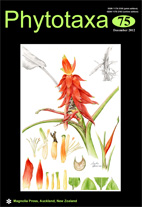Abstract
Bicudoa amazonica C.E. Wetzel, Lange-Bertalot & Ector gen. nov. et sp. nov. is described using light and scanning electron microscopy. It differs from ‘araphid’ genera by a unique combination of characters such as the absence of a raphe system, helictoglossae, rimoportulae, apical pore fields and linking spines, while other features including striae, areolae apparently without occlusion on valve and girdle elements, structure of the cingulum, and displacement of axial area place Bicudoa close to Eunotia. The taxonomic placement of the new organism at the class and family levels is discussed and it is concluded that placing Bicudoa in any of the current Fragilariophyceae families would be inappropriate. Instead, we place Bicudoa in the Bacillariophyceae and reserve the decision to place it in a family until further evidence is gathered. Based on ultrastructure, it is proposed that Bicudoa is a rather recent result of a complete loss of the raphe system and associated structures in a relatively recent eunotioid ancestor. Bicudoa amazonica was found in the upper reaches of the Rio Negro basin (Brazilian Amazon), a low pH, black water river (oligotrophic and humic). While the taxon was rare in plankton and benthic samples, it was rather common in excrement samples of the turtle Podocnemis erythrocephala (Testudines, Podocnemididae). The discovery of Bicudoa amazonica besides to the recent description of several new eunotioid taxa from Rio Negro basin suggests that speciation and isolation leading to endemism in Amazonian oligotrophic/dystrophic habitats is remarkable.

